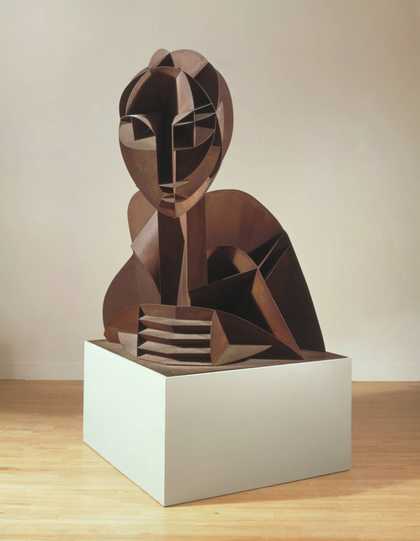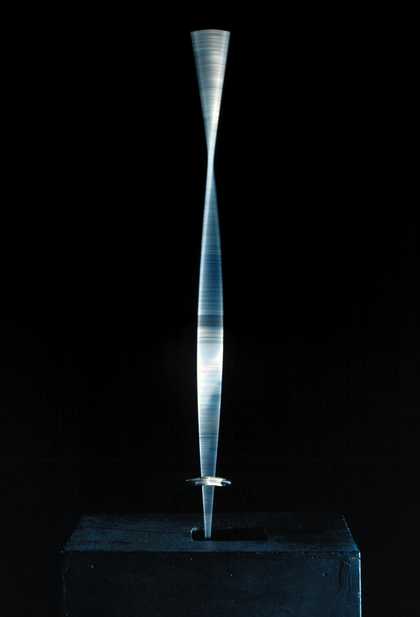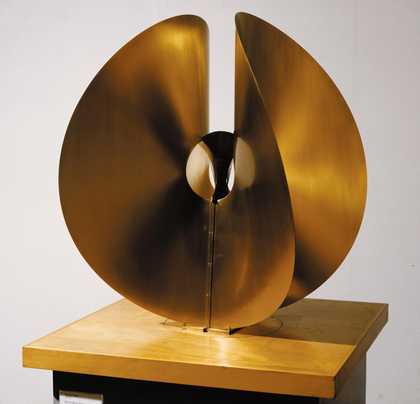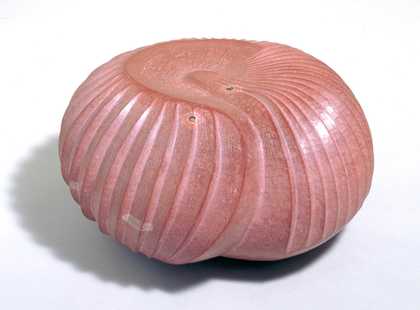Constructions for real life

Naum Gabo
Head No. 2 (1916, enlarged version 1964)
Tate
The Work of Naum Gabo © Nina & Graham Williams / Tate, London 2023
The Russian-born visionary Naum Gabo (1890 –1977) believed in the power of art to communicate across social and cultural boundaries. A pioneer of international Constructivism, he created work responding to the ideas, materials and technologies of the 20th century. On the 100th anniversary of his influential declaration The Realistic Manifesto, Tate St Ives presents an extensive selection of Gabo’s ground-breaking sculptures, models, designs and prints that bought time, space and industrial materials into art for modern life.
In 1920, amid the political fervour of post-revolutionary Russia, Gabo and his brother Antoine Pevsner posted The Realistic Manifesto across the official hoardings of Moscow. The poster broadcast their radical artistic principles and intent to make new forms of art for a developing modern society. In an age of scientific and technological advancement and social and political upheaval, Gabo asserted that the dimensions of space and time were essential to new ideas in
art as the ‘only forms on which Life is built and hence art must be constructed’. These ‘constructive’ ideals evolved with Gabo as he moved through Europe in pursuit of freedom to forge his artistic vision. He moved to St Ives in 1939 and became central to the growing community of international artists who relocated to the town during the Second World War.
A truly trans-national artist Gabo studied in Germany, worked in Norway, and contributed to developments in modernism on location in Moscow, Berlin, Paris, London and St Ives before settling in the United States. His career saw him achieve major international commissions and recognised as an accomplished writer and theorist through his teaching, lectures and publications. This exhibition celebrates Naum Gabo’s expansive body of work and his innovative approach and thinking that has influenced international artists, designers and architects for over a century.
Curated by Anne Barlow, Director Tate St Ives, Sara Matson, Exhibition and Displays Curator, Tate St Ives, and Natalia Sidlina, Curator, International Art, Tate Modern with Giles Jackson, Assistant Curator, Tate St Ives, Helen Bent, Registrar and Sally Noall, Interpretation Curator
With thanks to Nina and Graham Williams; Berlinischer Galerie, Berlin; the Scottish National Gallery of Modern Art, Edinburgh; i-DAT at the University of Plymouth
Space and Motion

Naum Gabo
Kinetic Construction (Standing Wave) (1919–20, replica 1985)
Tate
The Work of Naum Gabo © Nina & Graham Williams / Tate, London 2023
The Realistic Manifesto made a bold statement when Gabo posted it across the billboards of Moscow a century ago. At a time when social and political systems were restructuring, Gabo used this official media channel to distribute his vision for art which would nurture a progressive society. Gabo challenged conventional artistic methods and ideas declaring that modern art belonged in everyday living and so should be constructed on the ‘real laws of Life’. Embodying scientific and technological developments and contemporary philosophical thinking, the manifesto set space and time as essential materials in art for a modern life and world.
In his exploration of form and space, Gabo aimed to unlock the hidden rhythms and forces within his sculptures by opening up their volume. He developed the ‘stereometric’ technique of constructing works from interlocking sheets of card, wood and steel to capture space between the assembled parts. This method enabled Gabo to define the ‘inner space’ in sculpture, describing the form and depth of his figures through the space that they occupy rather than presenting them as conventional surface and mass. Following this, he pioneered his first fully abstract work Kinetic Construction (Standing Wave). Like versions of other works in this room, it was shown in an exhibition accompanying The Realistic Manifesto to demonstrate Gabo’s final principle of space and ‘kinetic rhythms’. Casting off the static forms of traditional sculpture, a single rod creates the illusion of a form as it vibrates in space. It is one of the first motorised sculptures in Western art.
Architecture
Gabo considered art crucial to everyday modern life and artistic practice as central to building a new society. Following current ideas in science, philosophy and engineering, he created designs that reimagined the future of public buildings and redefined social spaces with the intervention of sculptural forms. Fusing art with architecture, he asserted ‘From the very beginning of the Constructive Movement it was clear to me that a constructed sculpture, by its very method and technique, brings sculpture very near to architecture.’ Constructing for a new world, Gabo devised new types of architecture including high-rise buildings, car parks and space-age elevated airports inspired by the possibilities of civilair travel.
Working with glass, and later with newly developed plastics, Gabo further revealed the interior space of his sculptures begun with the open construction of the ‘stereometric’ technique. Through his studies in engineering, he was able to design towering monuments dedicated to communication and technological progress. He envisaged an open architecture built from transparent glass and plastics, using the clear materials and reflections of light to dissolve the edges, shape and form of his structures. The buildings would be animated by the rhythms of occupants moving through and around his dynamic spaces and streamlined forms. Although unrealised, Gabo’s curving shell-like 1931 proposal for the Palace of Soviets competition, a new congress centre for Moscow, predicted the influence of organic forms on post-war architecture.
Stage and Film
Gabo took his experiments in light and movement onto the stage with his radical designs for Sergei Diaghilev’s 1927 production of the ballet La Chatte. Working with foremost contemporary choreographers, Gabo created an immersive environment brought to life through the rhythms of dance, music and light. Extending his sculptural ideas, he draped the entire stage in glossy black fabric on which he placed a futuristic transparent set. Gabo also designed costumes with reflective elements that cast rhythms of light as dancers performed the stylised movements of George Balanchine’s ‘mathematical choreography’. Using a limited palette of black, white and yellow combined with matt and shiny surfaces, the edges and surfaces of the set were animated by flickers of bright light and deep shadow mirroring the qualities of contemporary film.
For Gabo, film offered a way to energise his abstract forms as a moving image. From his experience with La Chatte, he went on to propose projects with stop animations using multiple drawings to capture transformations of lines and shapes. When played on a screen the forms were to move in rhythm with the accompanying music. Another proposal used the latest sound-film to run multiple photographs of sculptures that would appear to change in time with different styles of music. Gabo’s ideas for abstract films went unrealised due to the technological limitations and prohibitive costs of film-making at the time.
Forces of Nature

Naum Gabo
Bronze Spheric Theme (c.1960)
Tate
The Work of Naum Gabo © Nina & Graham Williams / Tate, London 2023
Gabo often drew inspiration from the organic forms and natural phenomena around him. He carved in stone to unleash its natural dynamics and later began to experiment with photography to capture patterns in light, affirming that ‘One can create a work of art out of the dirt of the earth or out of the rays of the sun’.
Gabo’s childhood interest in nature intensified when he moved to Cornwall in 1939 at the outbreak of the Second World War. Fascinated by natural systems that determine shapes and forms, Gabo looked to the qualities of crystals, organic growth patterns and the processes of wind and water. He began to express these ‘hidden forces of nature’ using newly available transparent materials to reveal structures in natural and geometrical forms. In St Ives, he developed the technique of winding nylon filament in progressive mathematical patterns across inner sculptural supports fashioned from Perspex. The strung works transmit motion and light along their threads to reveal dynamism and radiance within their interior form. From these sculptures, Gabo evolved fountain projects and public designs using jets of water to create lines, curves and circular motion. Revolving Torsion, Fountain captures the natural forces and dynamics of spouting water to make moving compositions and visual forms. Combining natural systems with linear structures became characteristic of Gabo’s later work.
Rhythm and Music
Gabo’s experiments in painting and print allowed him to envisage more complex structures than could be created in sculptural form. Introducing a limited palette of colour, he began to explore gradations of tone and light to effect depth, direction and rhythm across the surface. He also motorised some of his paintings, rotating them to induce rhythmic movement within the painted forms and flowing together all the potential aspects of the same image over time.
Gabo regarded music as ‘the highest and the most pure form of abstract art’ and as the ultimate universal language of communication. He understood music as constructed upon a repeated motif and a ‘guiding rhythm’, on which harmonies of changing notes and phrases are built over time. The recurring patterns that hold together individual sounds and notes in music spoke to Gabo’s interest in rhythm, tempo and time. His Opus print series takes the name of a musical term for a sequence of compositions numbered in order of creation. Based on rhythms in poetry and music, Gabo altered the orientation of multiple woodcut impressions to produce variations of a repeated core design.
Living through revolutions, civil unrest and wars of the 20th century, Gabo retained an optimism and idealism in his belief of art to nurture a wounded society towards a progressive and modern future. He later said of his work ‘I have chosen the absoluteness and exactitude of my lines, shapes and forms in the conviction that they are the most immediate medium for my communication to others of the rhythms and the state of mind I would wish the world to be in. This is not only in the material world surrounding us, but also in the mental and spiritual world we carry within us’.



